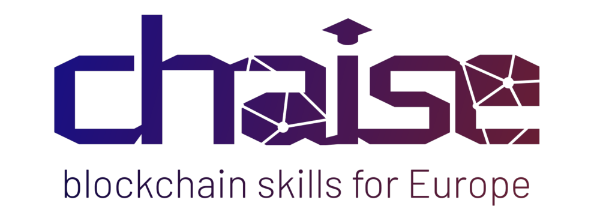Unterschreiben Sie die CHAISE-Unterstützungserklärung
Die Blockchain Skills for Europe Alliance (CHAISE) lädt Organisationen dazu ein, die Projektziele und -ergebnisse durch eine Unterstützungserklärung zu unterstützen.
Was ist der Zweck der Unterstützungserklärung?
Die aktuelle Unterstützungserklärung ruft Blockchain-Akteure aus ganz Europa, wie IT-Unternehmen, Branchenvertreter, politische Akteure, Sozialpartner, Standardisierungsorganisationen, nationale Qualifikationsagenturen, Berufs- und Hochschuleinrichtungen, Ausbilder/Mentoren und Experten aus der Praxis dazu auf:
- die sich abzeichnenden Berufsbilder im Bereich Blockchain und die definierten Qualifikations- und Wissensanforderungen zu erkennen und
- zur Förderung der Projektziele beizutragen, um die Ausbildung in digitalen Kompetenzen zu stärken, basierend auf den Prinzipien des gemeinsamen Interesses, der Gegenseitigkeit und der Komplementarität.
Die von CHAISE definierten Blockchain-Berufsprofile
CHAISE führte eine umfassende und neuartige Analyse durch, um den Blockchain-Sektor abzugrenzen und den Bedarf an Blockchain-Kompetenzen, das Angebot und die Diskrepanzen zu definieren. Diese Analyse zeigte das Aufkommen von drei neuen Rollen (Profilen) im europäischen Blockchain-Bereich: Blockchain-Entwickler, Blockchain-Architekt und Blockchain-Manager. Blockchain-Entwickler, Blockchain-Architekt, and Blockchain-Manager.
Der Blockchain-Entwickler kodiert die Blockchain-Anwendungen und kümmert sich um die Problemlösung auf der Mikroebene. Diese Arbeit erfordert allgemeine Softwareentwicklungsfähigkeiten mit großem Schwerpunkt auf den Entwicklungsfähigkeiten der Blockchain-Technologie und -Anwendungen, operative Geschäftsfähigkeiten und alle übergreifenden Zukunftsfähigkeiten, insbesondere selbstverwaltetes Arbeiten.
Essenzielle Kompetenzen
- Erkennen von Blockchain-Anwendungsbereichen
- Erkennen der Risiken von Blockchain und Kryptowährungen
- Erläutern der Auswirkungen der Blockchain-Technologie und -Steuerung
- Erkennen von durch die Blockchain-Technologie ermöglichten Innovationsmöglichkeiten
- Erläutern von Blockchain-basiertem Identitätsmanagement und Blockchain-basierter Zugriffskontrolle
- Erläutern der Grundsätze der DLT-Systemarchitektur
- Bewertung von Blockchain-Architekturen
- Innovation von Blockchain-Architekturen
- Analysieren dezentraler Anwendungen
- Implementierung von Smart Contracts
Essenzielles Wissen
- Blockchain-Konzepte und -Komponenten
- Blockchain-Anwendungen
- Blockchain-Geschichte
- Rechtliches Umfeld von Blockchain-basierten Produkten und Dienstleistungen
- Blockchain-Terminologie
- Grundsätze der Sicherheit von Blockchain-Anwendungen
- Blockchain-basierte Geschäftsmodelle
- Blockchain-Anwendungsbereiche
- Grundsätze der Informations- und Datensicherheit
- Schwachstellen in Distributed-Ledger-Technologien
- Management digitaler Identitäten
- Dezentralisierte Identifikatoren (DiD)
- Designprozess für Blockchain-basierte Systeme
- Blockchain-Designmuster
- DLT-Konsensprotokolle
- Programmiersprache für Smart Contracts
- Spieltheorie
- Spieltheorie für die Blockchain
Der Blockchain-Architekt entwirft die mehrstufige Architektur eines großen Blockchain-Systems und einer Software-Landschaft und gewährleistet die Kohärenz aller Aspekte eines Projekts als integriertes System. Außerdem stellt der Blockchain-Architekt die technische Gesamtqualität der Blockchain-Anwendung sicher. Diese Arbeit erfordert eine starke Mikro- und Makroperspektive. Sie hat einen starken Fokus auf die Entwicklung kreativer Projekte im Bereich Produkt- und Use-Case-Design, einschließlich der Konzeption und des Designs von Blockchain-Lösungen. Der Blockchain-Architekt ist vergleichbar mit der Rolle des Lösungsarchitekten. Sie sind ICT-Systemarchitekten, die auf Blockchain-basierte Lösungen spezialisiert sind. Sie entwerfen die mehrstufige Architektur einer großen Blockchain-System- und Softwarelandschaft und stellen die Kohärenz aller Aspekte eines Projekts als integriertes System sicher. Außerdem stellt der BC-Architekt die technische Gesamtqualität der BC-Anwendung sicher.
Essenzielle Kompetenzen
- Erkennen von Blockchain-Anwendungsbereichen
- Erkennen der Risiken von Blockchain und Kryptowährungen
- Erläutern der Auswirkungen der Blockchain-Technologie und -Steuerung
- Erkennen von durch die Blockchain-Technologie ermöglichten Innovationsmöglichkeiten
- Erläutern von Blockchain-basiertem Identitätsmanagement und Blockchain-basierter Zugriffskontrolle
- Erläutern der Grundsätze der DLT-Systemarchitektur
- Bewertung von Blockchain-Architekturen
- Innovation von Blockchain-Architekturen
- Kryptographische Konstrukte implementieren
- Blockchain-Anwendungsfälle analysieren
- Einführung von Blockchain in einer Anwendung
Essenzielles Wissen
- Blockchain-Konzepte und -Komponenten
- Blockchain-Anwendungen
- Blockchain-Geschichte
- Rechtliches Umfeld von Blockchain-basierten Produkten und Dienstleistungen
- Blockchain-Terminologie
- Grundsätze der Sicherheit von Blockchain-Anwendungen
- Blockchain-basierte Geschäftsmodelle
- Blockchain-Anwendungsbereiche
- Grundsätze der Informations- und Datensicherheit
- Schwachstellen in Distributed-Ledger-Technologien
- Management digitaler Identitäten
- Dezentralisierte Identifikatoren (DiD)
- Designprozess für Blockchain-basierte Systeme
- Blockchain-Designmuster
- DLT-Konsensprotokolle
- Blockchain-Signaturverfahren
- Anwendung des Blockchain-Konzepts
Der Blockchain-Manager leitet Gruppen von Entwicklern und Architekten. Der Blockchain-Manager verfolgt den Implementierungsfortschritt und pflegt eine enge Zusammenarbeit mit Geschäftsmanagern oder Marketingexperten, um die Marktanforderungen für neue Blockchain-Systeme und -Anwendungen zu ermitteln. Diese Arbeit überwacht die Prozessqualität, um sicherzustellen, dass die Produkte die technischen und geschäftlichen Ziele erfüllen, einschließlich der ethischen Reflexion möglicher Anwendungsbereiche der Technologie. Sie beinhaltet die Kommunikation mit anderen Stakeholdern, wie Abteilungsleitern und Marketingfachleuten. Darüber hinaus muss diese Rolle die Prozessqualität überwachen, um sicherzustellen, dass die Produkte ihre technischen und geschäftlichen Ziele erfüllen, und mit anderen Stakeholdern, wie Abteilungsleitern und Marketingfachleuten, kommunizieren.
Essenzielle Kompetenzen
- Erkennen von Blockchain-Anwendungsbereichen
- Erkennen der Risiken von Blockchain und Kryptowährungen
- Erläutern der Auswirkungen der Blockchain-Technologie und -Steuerung
- Erkennen von durch die Blockchain-Technologie ermöglichten Innovationsmöglichkeiten
- Erläutern von Blockchain-basiertem Identitätsmanagement und Blockchain-basierter Zugriffskontrolle
- Erläutern der Grundsätze der DLT-Systemarchitektur
- Bewertung von Blockchain-Architekturen
- Innovation von Blockchain-Architekturen
- Kryptographische Konstrukte implementieren
- Blockchain-Anwendungsfälle analysieren
- Einführung von Blockchain in einer Anwendung
Essenzielles Wissen
- Blockchain-Konzepte und -Komponenten
- Blockchain-Anwendungen
- Blockchain-Geschichte
- Rechtliches Umfeld von Blockchain-basierten Produkten und Dienstleistungen
- Blockchain-Terminologie
- Grundsätze der Sicherheit von Blockchain-Anwendungen
- Blockchain-basierte Geschäftsmodelle
- Blockchain-Anwendungsbereiche
- Grundsätze der Informations- und Datensicherheit
- Schwachstellen in Distributed-Ledger-Technologien
- Management digitaler Identitäten
- Dezentralisierte Identifikatoren (DiD)
- Designprozess für Blockchain-basierte Systeme
- Blockchain-Designmuster
- DLT-Konsensprotokolle
- Blockchain-Signaturverfahren
- Anwendung des Blockchain-Konzepts
Das CHAISE Blockchain VET-Programm
Die CHAISE-Partnerschaft hat einen Lehrplan für die berufliche Bildung entwickelt, um die Lücke im Angebot und in der Qualität der bestehenden formalen und nicht-formalen Ausbildung für die neu entstehenden Blockchain-Rollen zu schließen. Darüber hinaus befasst sich der Lehrplan mit den sich entwickelnden Bedürfnissen des Arbeitsmarktes und den Qualifikationsanforderungen, die sich aus der zunehmenden Einführung von Blockchain-Anwendungsfällen in allen Wirtschaftssektoren ergeben.
Der CHAISE-Lehrplan für die berufliche Bildung umfasst Module, die in den drei Blockchain-Rollen (Entwickler, Architekt und Manager) im ersten Ausbildungsjahr gleich sind, sowie Spezialisierungslehrgänge für jede dieser Rollen nach dem zweiten Ausbildungsjahr. Das Programm hat eine Dauer von 5 Semestern und entspricht dem EQR 5.
Mehr Informationen zur Unterstützungserklärung!
Erkennen Sie die CHAISE-Ergebnisse an und zeigen Sie Ihre Unterstützung!
Durch die Anerkennung der Ergebnisse tragen Sie zu einer klareren Beschreibung der verschiedenen Blockchain-Rollen und eines möglichen Bildungsansatzes bei, der auf verschiedene Länder und Märkte übertragbar ist, und leisten damit einen Beitrag zu den gemeinsamen Bemühungen, den wachsenden Anforderungen des Blockchain-Sektors gerecht zu werden.
Ergänzen Sie das folgende Formular!
